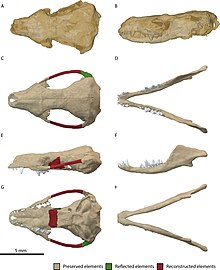Hadrocodium
| Hadrocodium Temporal range: Sinemurian
~ | |
|---|---|

| |
| Scientific classification | |
| Domain: | Eukaryota |
| Kingdom: | Animalia |
| Phylum: | Chordata |
| Clade: | Synapsida |
| Clade: | Therapsida |
| Clade: | Cynodontia |
| Clade: | Mammaliaformes |
| Genus: | †Hadrocodium Luo, Crompton, & Sun, 2001 |
| Species: | †H. wui
|
| Binomial name | |
| †Hadrocodium wui | |
Hadrocodium wui is an extinct mammaliaform that lived during the Sinemurian stage of the Early Jurassic approximately 195 million years ago[1] in the Lufeng Formation in what is now the Yunnan province in south-western China[2] (25°12′N 102°06′E / 25.2°N 102.1°E, paleocoordinates 34°18′N 104°54′E / 34.3°N 104.9°E).[3] It is considered as the closest relative of the class Mammalia.

The fossil of this mouse-like, paper-clip sized animal was discovered in 1985 but was then interpreted as a juvenile morganucodontid.[4] Hadrocodium remained undescribed until 2001; since then its large brain and advanced ear structure[5] have greatly influenced the interpretation of the earliest stages of mammalian evolution, as these mammalian characters could previously be traced only to some 150 million years ago.[6] Hadrocodium is known only from a skull 1.2 cm (0.47 in) long, and its body would have measured 3.2 cm (1.3 in) long in total and weighed up to 2 g (0.071 oz), making it one of the smallest Mesozoic mammaliaforms.[1][7][8] The specimen is thought to have been that of a mature adult.[9]
The name Hadrocodium alludes to its large cranial cavity,[10] deriving from the Greek word hadrós (ἁδρός 'large, heavy, fullness')[4] and the Latin word codium, from Greek kṓdeia (κώδεια 'head [of a plant]').[11] The species name, wui, is the Latinized version of discoverer Xiao-Chun Wu's name.[2]
While initially suggested to have possessed a fully mammalian ear akin to those of modern mammals, a 2022 restudy suggested that it actually had a primitive mandibular middle ear similar to those of other primitive mammaliaforms.[9] In 2025, Tumelty and Lautenschlager examined the cranium and mandible of Hadrocodium in comparison with those of modern moles and shrews, and concluded that Hadrocodium might have fed on softer invertebrates and that it's probably not a fully fossorial animal.[12]
Phylogeny
[edit]- Phylogeny [13]
See also
[edit]References
[edit]- ^ a b Luo, Crompton & Sun 2001, Abstract
- ^ a b Parsell 2001
- ^ Hei Koa Peng, Lufeng (CUP, IVPP) (Jurassic of China) in the Paleobiology Database. Retrieved April 2013.
- ^ a b Luo, Crompton & Sun 2001, Note 1
- ^ CNN 2001
- ^ CMNH 2001
- ^ T. S. Kemp (2005). The Origin and Evolution of Mammals. Oxford University Press, USA. p. 183. ISBN 9780198507611. Retrieved 22 September 2022.
- ^ Donald R. Prothero (November 15, 2016). The Princeton Field Guide to Prehistoric Mammals. Princeton University Press. p. 27. ISBN 9780691156828.
- ^ a b Luo, Zhexi; Bhullar, Bhart-Anjan; Crompton, Alfred; Neander, April; Rowe, Timothy (2022). "Reexamination of the Mandibular and Dental Morphology of the Early Jurassic Mammaliaform Hadrocodium wui". Acta Palaeontologica Polonica. 67. doi:10.4202/app.00949.2021. ISSN 0567-7920.
- ^ Luo, Z.-X. (2001). "A New Mammaliaform from the Early Jurassic and Evolution of Mammalian Characteristics". Science. 292 (5521): 1535–40. Bibcode:2001Sci...292.1535L. doi:10.1126/science.1058476. PMID 11375489. S2CID 8738213.
- ^ Liddell & Scott 1940
- ^ Tumelty, M.; Lautenschlager, S. (2025). "Is cranial anatomy indicative of fossoriality? A case study of the mammaliaform Hadrocodium wui". The Anatomical Record. doi:10.1002/ar.25630. PMID 39853864.
- ^ Close, Roger A.; Friedman, Matt; Lloyd, Graeme T.; Benson, Roger B.J. (2015). "Evidence for a mid-Jurassic adaptive radiation in mammals". Current Biology. 25 (16): 2137–2142. doi:10.1016/j.cub.2015.06.047. PMID 26190074.
Bibliography
[edit]- "Hadrocodium wui". Carnegie Museum of Natural History. 2001. Archived from the original on 2012-06-17. Retrieved 1 April 2013.
- "Tiny creature may be ancestor of all mammals". CNN. May 24, 2001. Archived from the original on 18 September 2009. Retrieved 1 April 2013.
- Liddell, Henry George; Scott, Robert (1940). "A Greek–English Lexicon: κώδεια". Perseus Digital Library. Retrieved 1 April 2013.
- Luo, Zhe-Xi; Crompton, Alfred W.; Sun, Ai-Lin (2001). "A New Mammaliaform from the Early Jurassic and Evolution of Mammalian Characteristics" (PDF). Science. 292 (5521): 1535–1540. Bibcode:2001Sci...292.1535L. doi:10.1126/science.1058476. PMID 11375489. S2CID 8738213. Archived from the original (PDF) on 2013-08-20.
- Parsell, D.L. (May 24, 2001). "Tiny Fossil From Early Jurassic Fills New Niche in Mammal Evolution". National Geographic News. Archived from the original on August 13, 2001. Retrieved 1 April 2013.
- Rowe, Timothy; Macrini, Thomas E; Luo, Zhe-Xi (May 2011). "Fossil Evidence on Origin of the Mammalian Brain". Science. 332 (955): 955–7. Bibcode:2011Sci...332..955R. doi:10.1126/science.1203117. PMID 21596988. S2CID 940501. (Supporting online material)
External links
[edit]- Rowe, Timothy; Macrini, Thomas E; Luo, Zhe-Xi (2006). "Hadrocodium wui (On-line)". Digital Morphology at the University of Texas. Retrieved 1 April 2013. — 3D models from CT scans of the original fossil
- Palaeocritti - a guide to prehistoric animals






